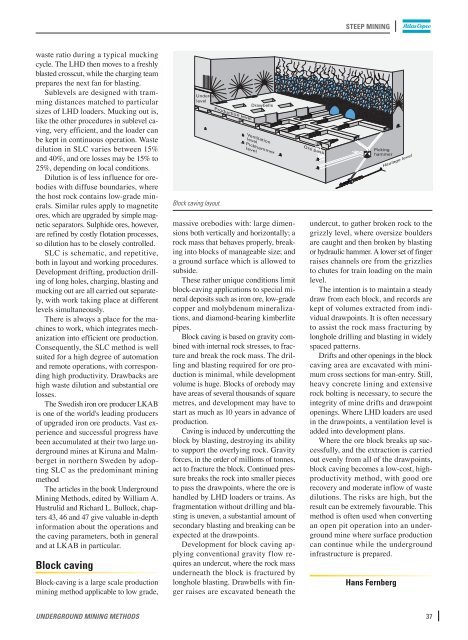Mining_Methods_UnderGround_Mining - Mining and Blasting
Mining_Methods_UnderGround_Mining - Mining and Blasting
Mining_Methods_UnderGround_Mining - Mining and Blasting
Create successful ePaper yourself
Turn your PDF publications into a flip-book with our unique Google optimized e-Paper software.
waste ratio during a typical mucking<br />
cycle. The LHD then moves to a freshly<br />
blasted crosscut, while the charging team<br />
prepares the next fan for blasting.<br />
Sublevels are designed with tramming<br />
distances matched to particular<br />
sizes of LHD loaders. Mucking out is,<br />
like the other procedures in sublevel caving,<br />
very efficient, <strong>and</strong> the loader can<br />
be kept in continuous operation. Waste<br />
dilution in SLC varies between 15%<br />
<strong>and</strong> 40%, <strong>and</strong> ore losses may be 15% to<br />
25%, depending on local conditions.<br />
Dilution is of less influence for orebodies<br />
with diffuse boundaries, where<br />
the host rock contains low-grade minerals.<br />
Similar rules apply to magnetite<br />
ores, which are upgraded by simple mag-<br />
netic separators. Sulphide ores, however,<br />
are refined by costly flotation processes,<br />
so dilution has to be closely controlled.<br />
SLC is schematic, <strong>and</strong> repetitive,<br />
both in layout <strong>and</strong> working procedures.<br />
Development drifting, production drilling<br />
of long holes, charging, blasting <strong>and</strong><br />
mucking out are all carried out separately,<br />
with work taking place at different<br />
levels simultaneously.<br />
There is always a place for the machines<br />
to work, which integrates mechanization<br />
into efficient ore production.<br />
Consequently, the SLC method is well<br />
suited for a high degree of automation<br />
<strong>and</strong> remote operations, with corresponding<br />
high productivity. Drawbacks are<br />
high waste dilution <strong>and</strong> substantial ore<br />
losses.<br />
The Swedish iron ore producer LKAB<br />
is one of the world's leading producers<br />
of upgraded iron ore products. Vast ex-<br />
perience <strong>and</strong> successful progress have<br />
been accumulated at their two large un-<br />
derground mines at Kiruna <strong>and</strong> Malmberget<br />
in northern Sweden by adop-<br />
ting SLC as the predominant mining<br />
method<br />
The articles in the book Underground<br />
<strong>Mining</strong> <strong>Methods</strong>, edited by William A.<br />
Hustrulid <strong>and</strong> Richard L. Bullock, chapters<br />
43, 46 <strong>and</strong> 47 give valuable in-depth<br />
information about the operations <strong>and</strong><br />
the caving parameters, both in general<br />
<strong>and</strong> at LKAB in particular.<br />
Block caving<br />
Block-caving is a large scale production<br />
mining method applicable to low grade,<br />
Undercut<br />
level<br />
Block caving layout.<br />
Production level<br />
Drawbells<br />
Ventilation<br />
level<br />
Pickhammer<br />
level<br />
massive orebodies with: large dimensions<br />
both vertically <strong>and</strong> horizontally; a<br />
rock mass that behaves properly, breaking<br />
into blocks of manageable size; <strong>and</strong><br />
a ground surface which is allowed to<br />
subside.<br />
These rather unique conditions limit<br />
block-caving applications to special mi-<br />
neral deposits such as iron ore, low-grade<br />
copper <strong>and</strong> molybdenum mineralizations,<br />
<strong>and</strong> diamond-bearing kimberlite<br />
pipes.<br />
Block caving is based on gravity com-<br />
bined with internal rock stresses, to frac-<br />
ture <strong>and</strong> break the rock mass. The dril-<br />
ling <strong>and</strong> blasting required for ore production<br />
is minimal, while development<br />
volume is huge. Blocks of orebody may<br />
have areas of several thous<strong>and</strong>s of square<br />
metres, <strong>and</strong> development may have to<br />
start as much as 10 years in advance of<br />
production.<br />
Caving is induced by undercutting the<br />
block by blasting, destroying its ability<br />
to support the overlying rock. Gravity<br />
forces, in the order of millions of tonnes,<br />
act to fracture the block. Continued pres-<br />
sure breaks the rock into smaller pieces<br />
to pass the drawpoints, where the ore is<br />
h<strong>and</strong>led by LHD loaders or trains. As<br />
fragmentation without drilling <strong>and</strong> blasting<br />
is uneven, a substantial amount of<br />
secondary blasting <strong>and</strong> breaking can be<br />
expected at the drawpoints.<br />
Development for block caving ap-<br />
plying conventional gravity flow re-<br />
quires an undercut, where the rock mass<br />
underneath the block is fractured by<br />
longhole blasting. Drawbells with finger<br />
raises are excavated beneath the<br />
STeeP <strong>Mining</strong><br />
Picking<br />
hammer<br />
undercut, to gather broken rock to the<br />
grizzly level, where oversize boulders<br />
are caught <strong>and</strong> then broken by blasting<br />
or hydraulic hammer. A lower set of finger<br />
raises channels ore from the grizzlies<br />
to chutes for train loading on the main<br />
level.<br />
The intention is to maintain a steady<br />
draw from each block, <strong>and</strong> records are<br />
kept of volumes extracted from individual<br />
drawpoints. It is often necessary<br />
to assist the rock mass fracturing by<br />
longhole drilling <strong>and</strong> blasting in widely<br />
spaced patterns.<br />
Drifts <strong>and</strong> other openings in the block<br />
caving area are excavated with minimum<br />
cross sections for man-entry. Still,<br />
heavy concrete lining <strong>and</strong> extensive<br />
rock bolting is necessary, to secure the<br />
integrity of mine drifts <strong>and</strong> drawpoint<br />
openings. Where LHD loaders are used<br />
in the drawpoints, a ventilation level is<br />
added into development plans.<br />
Where the ore block breaks up suc-<br />
cessfully, <strong>and</strong> the extraction is carried<br />
out evenly from all of the drawpoints,<br />
block caving becomes a low-cost, highproductivity<br />
method, with good ore<br />
recovery <strong>and</strong> moderate inflow of waste<br />
dilutions. The risks are high, but the<br />
result can be extremely favourable. This<br />
method is often used when converting<br />
an open pit operation into an underground<br />
mine where surface production<br />
can continue while the underground<br />
infrastructure is prepared.<br />
Hans Fernberg<br />
Haulage level<br />
underground mining methods 37<br />
Ore pass
















